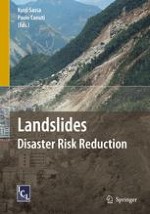2009 | OriginalPaper | Buchkapitel
Landslide Risk Assessment and Mitigation Strategy
verfasst von : Suzanne Lacasse, Farrokh Nadim, Suzanne Lacasse, Farrokh Nadim
Erschienen in: Landslides – Disaster Risk Reduction
Verlag: Springer Berlin Heidelberg
Aktivieren Sie unsere intelligente Suche, um passende Fachinhalte oder Patente zu finden.
Wählen Sie Textabschnitte aus um mit Künstlicher Intelligenz passenden Patente zu finden. powered by
Markieren Sie Textabschnitte, um KI-gestützt weitere passende Inhalte zu finden. powered by
Each year, natural disasters cause countless deaths and formidable damage to infrastructure and the environment. In 2004–2005, more than 200 000 people lost their lives in natural disasters. Material damage was estimated at USD 300 billion. Many lives could have been saved if more had been known about forecasting and mitigation. The need to improve the ability to deal with the hazards and risks was accentuated by increased sliding and flooding in many regions around the world in recent years, concern for their disastrous consequences on mankind, infrastructure and material property and the catastrophic Indian Ocean tsunami in December 2004.
One of the most common natural disasters is landslides caused by heavy precipitation, floods, earthquakes and erosion, and by anthropogenic actions. Many of the casualties reported after rainstorms, large floods and earthquakes are actually caused by the landslides triggered by these events. Studies show that developing countries are greatly affected by landslides. Of the total number of persons who died due to natural disasters, highly developed countries count only 5% of the casualties. Material damage in Industrialized countries is however greatest. International collaboration is needed to reduce losses in countries where the landslide risk is high. The measures for effective mitigation require solutions encompassing the technological and the societal perspectives, which demonstrate the importance and challenge of a multi-disciplinary approach, where scientists and engineers need to interact and communicate freely with partners with entirely different backgrounds. The paper presents recent work on the assessment, mitigation and management of landslide risk, including several examples. Societal aspects risk, are considered. Early warning systems have gained strong interest in recent years. The paper goes into the principles and elements of early warning systems, the key factors for success and some of the available technology. Society and technologists need to invest into the mitigation of landslide hazard and risk to improve the reliability and efficiency of the results obtained.
